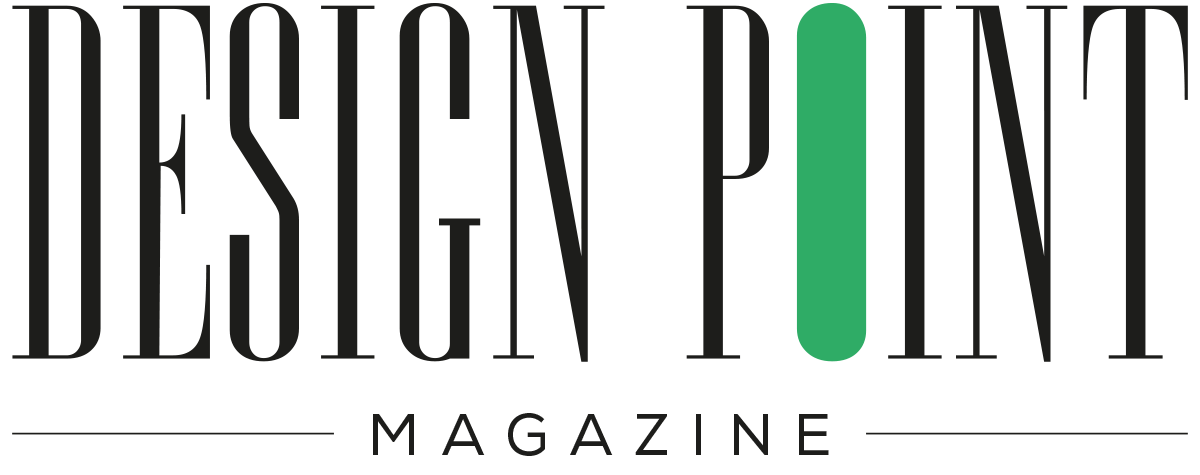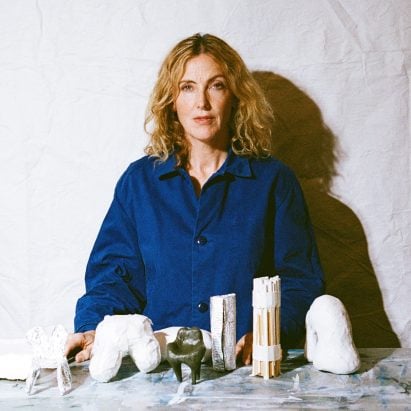As Stockholm Furniture Fair begins, Dezeen spoke to this year’s guest of honour, British designer Faye Toogood, about how the rise of artificial intelligence has created a need for humanity in design.
Toogood has a more unusual background than many of her contemporaries. She trained as an artist, studying fine art and working in sculpture, before moving into a role as editor and stylist at the monthly magazine World of Interiors.
Those early years in her career have formed Toogood into the designer she is today.
“I left (World of Interiors) because I got quite frustrated with the two-dimensional page and wanted to do something more three-dimensional,” she remembered. “Everything is sort of edging me towards that sculpture background.”
“I don’t really like to apply the word ‘designer’ or ‘artist'”
Now working across several different fields, Toogood is reluctant to define whether she’s an artist, a designer or a fashion designer.
“People want a term, but I find it really difficult to do that – if you’re creative, you move between design and art and a creative way of seeing things,” Toogood explained.
“I don’t really like to apply the word ‘designer’ or ‘artist’, because I feel I’m a bit of both. My art background, and maybe being a female designer, is giving me a different viewpoint on design, which seems to be connecting and resonating in some way.”
Toogood, whose work includes the easily recognisable Roly-Poly Chair, has become one of the most influential British designers working today.
Toogood’s Puffy Lounge Chair won a Dezeen Award in 2021
Her Puffy Lounge Chair for Hem was awarded Seating Design of the Year at Dezeen Awards 2021, and she was recently named Designer of the Year 2025 by French trade fair Maison & Objet.
Toogood’s guest of honour exhibition at this year’s Stockholm Furniture Fair will focus on the “hands of craft”, the fair said. Called Manufracture, it will show pieces from her personal archives.
“‘I’m bringing a lot of prototypes, things that didn’t work or are half-made, showing the vulnerability of the designer and how sometimes the solutions are not always present – how many years it takes to get something off the ground, how many failures before a success,” Toogood said.
“Do we really need more chairs? The answer, probably, is no.”
The name Manufracture refers to two different things. First is Toogood’s belief that the manufacturing industry is broken.
“At the moment, we are making things in different parts of the world from materials from another part of the world, and then we’re shipping them around the world – because of the way the economy is, because of the way Brexit is, because of the way that the world is – and that is becoming prohibitively expensive,” she said.
“It’s the squeeze on the economy that’s making everybody look at this problem, but it’s a systemic problem that we need to deal with from a sustainability point of view. I don’t think we all know what the answers are, but we have to look at it. The way we’re designing and manufacturing is broken.”
Manufractured’s second aspect is the fracturing in the role of the designer.
Being a designer “used to be about solving problems or because we needed something”, Toogood said. “That’s not the case now, because aside from technology, we have everything we need. Do we really need more chairs? The answer, probably, is no.”
She believes this fracture is also underlined by the advent of artificial intelligence (AI) as a design tool.
“Surely AI will be able to design a better Faye Toogood chair than Faye Toogood,” she said. “In theory, what can I bring? It’s humanity and emotion – those are things that I feel are important, and designers now need to be focusing more on that.”
Faye Toogood’s Manufracture exhibition features numerous prototypes
She hopes that by highlighting the importance of the design process in the Manufracture exhibition, she will also help inform visitors about why higher prices are sometimes necessary.
“We all understand the difference between a £2.99 chicken and a £15 chicken. When it comes to food, we get what’s involved – how it’s been made, how it’s been reared, the process, what it’s been fed,” she said.
“But somehow we’re unable to make that connection with furniture and objects. And I have to say, things like homeware collections on the high street are also making that more difficult because they can copy things quicker than we can get it out there.”
Landscape “completely different” for female designers today
However, Toogood is still hopeful about the future of design in the UK. “British design, I’m proud to say I feel like – as ever – is very strong, the young designers have more attitude,” she said.
“It’s hard for them, they’re surrounded by a saturated world where there’s probably more designers than there is work. But I feel the fight, and they’re understanding that they have to be agile.”
For female designers, things have also improved since Toogood started out.
“In my early days, there were very few female designers to work as my mentors,” she recalled. “I felt like I had to remove gender as part of the equation, so I wouldn’t take any interviews on being a female in design.”
“I purposely took on quite seemingly masculine materials, in terms of heavy steel,” she added. “I was working a lot with welding, I didn’t work in textiles or ceramics – anything that could be considered decorative arts – and I removed colour and pattern from the work.”
This was in a bid to be taken seriously at the time, she explains.
“But I’m pleased to say that now, 15-20 years on, it feels like a completely different landscape. There are a lot more – though not enough – [women] in high positions in the design world. We’re getting there.
“I suddenly feel comfortable talking about being a woman designer.”
The photography is courtesy of Toogood. This article was originally written for the Dezeen Dispatch magazine at Stockholm Design Week 2025.
Stockholm Design Week 2025 is taking place at various locations around the city from 3 to 9 February. To see what’s on, visit Dezeen Events Guide.
The post “The way we’re designing and manufacturing is broken” says Faye Toogood appeared first on Dezeen.

